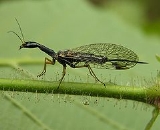
Snakefly
Overview
Snakeflies are a group of insect
s in the order
Raphidioptera, consisting of about 210 extant species
. Together with the Megaloptera
they were formerly placed within the Neuroptera
, but now these two are generally regarded as separate orders.
Snakeflies are predatory, both as adults and larva
e. They can be quite common throughout temperate Europe
and Asia
, but in North America
occur exclusively in the Western United States
, namely in the Rocky Mountains
and westward, including the southwestern desert
s.
Adult snakeflies are characterized by having an elongate prothorax
but no modification of the forelegs
(as in Mantispidae).
Insect
Insects are a class of living creatures within the arthropods that have a chitinous exoskeleton, a three-part body , three pairs of jointed legs, compound eyes, and two antennae...
s in the order
Order (biology)
In scientific classification used in biology, the order is# a taxonomic rank used in the classification of organisms. Other well-known ranks are life, domain, kingdom, phylum, class, family, genus, and species, with order fitting in between class and family...
Raphidioptera, consisting of about 210 extant species
Species
In biology, a species is one of the basic units of biological classification and a taxonomic rank. A species is often defined as a group of organisms capable of interbreeding and producing fertile offspring. While in many cases this definition is adequate, more precise or differing measures are...
. Together with the Megaloptera
Megaloptera
Megaloptera is an order of insects. It contains the alderflies, dobsonflies and fishflies, and there are about 300 known species.The Megaloptera were formerly considered part of a group then called Neuroptera, together with lacewings and snakeflies, but these are now generally considered to be...
they were formerly placed within the Neuroptera
Neuroptera
The insect order Neuroptera, or net-winged insects, includes the lacewings, mantidflies, antlions, and their relatives. The order contains some 6,010 species...
, but now these two are generally regarded as separate orders.
Snakeflies are predatory, both as adults and larva
Larva
A larva is a distinct juvenile form many animals undergo before metamorphosis into adults. Animals with indirect development such as insects, amphibians, or cnidarians typically have a larval phase of their life cycle...
e. They can be quite common throughout temperate Europe
Europe
Europe is, by convention, one of the world's seven continents. Comprising the westernmost peninsula of Eurasia, Europe is generally 'divided' from Asia to its east by the watershed divides of the Ural and Caucasus Mountains, the Ural River, the Caspian and Black Seas, and the waterways connecting...
and Asia
Asia
Asia is the world's largest and most populous continent, located primarily in the eastern and northern hemispheres. It covers 8.7% of the Earth's total surface area and with approximately 3.879 billion people, it hosts 60% of the world's current human population...
, but in North America
North America
North America is a continent wholly within the Northern Hemisphere and almost wholly within the Western Hemisphere. It is also considered a northern subcontinent of the Americas...
occur exclusively in the Western United States
Western United States
.The Western United States, commonly referred to as the American West or simply "the West," traditionally refers to the region comprising the westernmost states of the United States. Because the U.S. expanded westward after its founding, the meaning of the West has evolved over time...
, namely in the Rocky Mountains
Rocky Mountains
The Rocky Mountains are a major mountain range in western North America. The Rocky Mountains stretch more than from the northernmost part of British Columbia, in western Canada, to New Mexico, in the southwestern United States...
and westward, including the southwestern desert
Desert
A desert is a landscape or region that receives an extremely low amount of precipitation, less than enough to support growth of most plants. Most deserts have an average annual precipitation of less than...
s.
Adult snakeflies are characterized by having an elongate prothorax
Prothorax
The prothorax is the foremost of the three segments in the thorax of an insect, and bears the first pair of legs. Its principal sclerites are the pronotum , the prosternum , and the propleuron on each side. The prothorax never bears wings in extant insects, though some fossil groups possessed...
but no modification of the forelegs
Arthropod leg
The arthropod leg is a form of jointed appendage of arthropods, usually used for walking. Many of the terms used for arthropod leg segments are of Latin origin, and may be confused with terms for bones: coxa , trochanter , femur, tibia, tarsus, ischium, metatarsus, carpus, dactylus ,...
(as in Mantispidae).
Unanswered Questions

